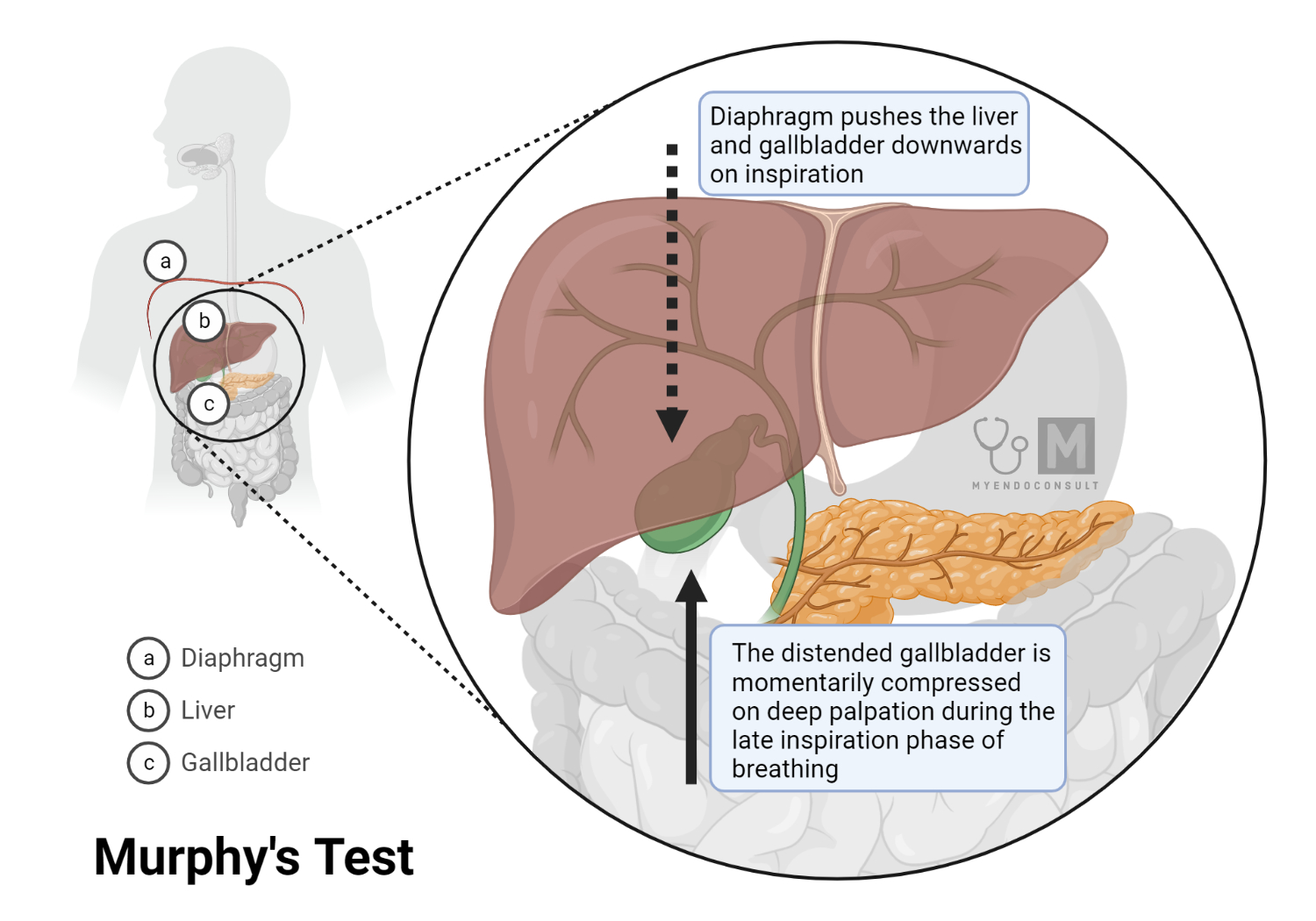Acute cholecystitis is a common clinical presentation involving gallbladder inflammation, typically due to gallstones obstructing the cystic duct. It can cause severe abdominal pain and tenderness. Murphy's sign is a valuable clinical test used to assess patients presenting with upper right quadrant pain to determine the likelihood of acute cholecystitis. This article provides an overview of the indications for performing Murphy's sign, the technique, interpretation of results, diagnostic accuracy, and considerations for older patients.
Indications
Murphy's sign is indicated for patients presenting with the following:
- Upper right quadrant pain or tenderness
- Suspicion of cholecystitis based on clinical presentation and history
Mechanism of Murphy’s Sign

The mechanism of Murphy's sign is based on the anatomical relationship between the gallbladder and the diaphragm, as well as the patient's response to the palpation of the inflamed gallbladder during inspiration.
The gallbladder is located in the upper right quadrant of the abdomen, hidden beneath the liver and near the lower ribs. In acute cholecystitis, the gallbladder becomes inflamed and distended, typically due to gallstones that obstruct the cystic duct. This inflammation makes the gallbladder tender and painful to touch.
When a patient takes a deep breath, the diaphragm contracts and moves downward, causing the liver and gallbladder to shift lower in the abdominal cavity. If the gallbladder is inflamed, this movement brings the tender, swollen gallbladder into contact with the examiner's fingers during the deep inspiration. This contact causes significant pain and tenderness in the patient, causing them to halt their inspiration abruptly.
A positive Murphy's sign occurs when the patient experiences pain or tenderness severe enough to cause an abrupt halt in inspiration, usually toward the end of the breath. This suggests acute cholecystitis. A negative Murphy's sign is when the patient can complete a full inspiration without significant pain or tenderness.
Performing the Physical Exam
To perform the Murphy's sign test, follow these steps:
- Have the patient lie supine on the exam table.
- Position your left hand, with fingers pointing toward the midline, on the patient's lowermost right anterior rib cage. Your index finger should rest on the most inferior rib.
- Extend your left thumb and push it into the patient's abdomen without leaning on the rib cage.
- Instruct the patient to take a deep breath, feeling the rib cage move toward you during inspiration.
- Observe the patient's breathing and assess the degree of tenderness.
- Repeat the test as a placebo maneuver by placing your hand in the same position but without pushing your thumb inward. Note if the patient can complete a full inspiration.
Interpretation of Results
A positive Murphy's sign occurs when the patient experiences pain or tenderness severe enough to cause an abrupt halt in inspiration, usually toward the end of the breath. This suggests acute cholecystitis.
Conversely, a negative Murphy's sign is when the patient can complete a full inspiration without significant pain or tenderness.
Diagnostic Accuracy
Murphy's sign has varying sensitivity and specificity, depending on the study:
- Sensitivity: 44% - 97%
- Specificity: 48% - 96%
- Positive likelihood ratio: 2.0
- Negative likelihood ratio: non-significant
In older patients, the diagnostic accuracy of Murphy's sign changes:
- Sensitivity: 48%
- Specificity: 79%
- Positive predictive value: 0.58
Notes and Considerations
The signs and symptoms of an acute abdomen in older patients may not be as classic or specific as those in younger patients. This difference may explain the lower sensitivity and specificity of Murphy's sign in elderly patients.
A positive Murphy's sign in older individuals is useful for diagnosing acute cholecystitis, but a negative sign does not exclude the possibility. In such cases, healthcare providers should promptly perform additional diagnostic tests.
Factors that can impact the accuracy of Murphy's sign include:
- Patient positioning: Ensure the patient is lying supine and comfortable during the exam. Incorrect positioning may lead to false-negative or false-positive results.
- Examiner technique: The examiner should apply adequate pressure with their thumb without leaning on the patient's rib cage. Insufficient pressure may yield false-negative results, while excessive pressure could cause a false-positive outcome.
- Patient cooperation: Encourage the patient to take slow, deep breaths during the exam. Inadequate inspiration can affect the accuracy of the test.
Conclusion
Murphy's sign is a valuable clinical tool for evaluating upper right quadrant pain and determining the likelihood of acute cholecystitis. Its diagnostic precision varies depending on the patient population and the proper execution of the technique. In older patients, a positive Murphy's sign is helpful for diagnosing cholecystitis, but a negative result does not rule it out. Healthcare providers
Kindly Let Us Know If This Was helpful? Thank You!


